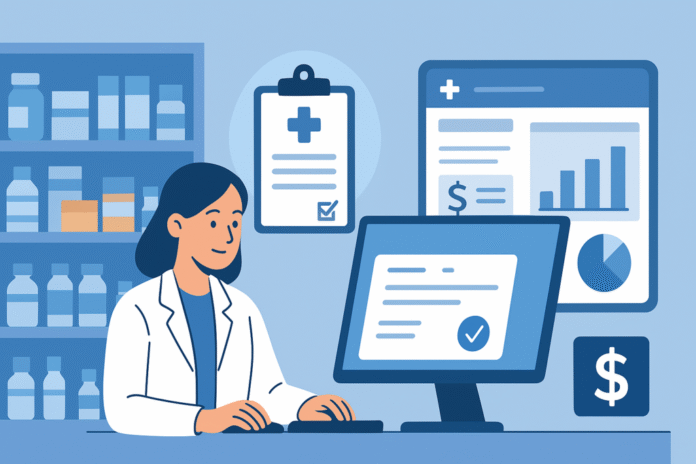Independent pharmacies have always been at the heart of community healthcare. They provide not only prescriptions but also personalized guidance, preventive care, and trusted relationships that larger retail chains often struggle to deliver. Yet, as the healthcare landscape grows increasingly complex, independent pharmacies face new challenges. Reimbursement pressures, regulatory demands, and the growing importance of clinical services have all placed strain on traditional models. To remain viable and competitive, pharmacies need to evolve into digitally enabled practices that operate as efficiently as any larger competitor. Two of the most important enablers in this transformation are pharmacy software and medical billing software.
These solutions are more than just tools to digitize basic workflows; they represent the foundation for sustainable growth in a changing healthcare economy. But adopting them is not without trade-offs. Pharmacy owners must balance cost, training, integration, and workflow changes, while ensuring that technology serves both the financial and clinical missions of the pharmacy. This article explores why these systems are so essential, the benefits they deliver, the trade-offs involved, and the broader implications for independent pharmacies striving to thrive in the modern marketplace.
Table of Contents
The Shifting Role of Independent Pharmacies
For much of the 20th century, pharmacies were primarily viewed as dispensing points for medications. Success was driven by volume, and reimbursement models favored product sales. Independent pharmacists competed largely in customer service and convenience. Over the last two decades, however, that model has eroded. Large chains, mail-order services, and now online pharmacies have captured much of the prescription dispensing market. At the same time, declining reimbursement rates from pharmacy benefit managers (PBMs) have made it harder for independent pharmacies to rely solely on filling prescriptions.
The new competitive advantage lies in expanding into clinical services—vaccinations, chronic disease management, medication therapy management, and wellness screenings. These services not only generate revenue but also strengthen the pharmacy’s role as a primary point of care. Yet clinical services also require accurate documentation, streamlined scheduling, and the ability to bill medical insurance directly. This is where technology becomes a decisive factor in enabling pharmacies to compete effectively.
Why Technology Has Become a Necessity, not a Luxury
Independent pharmacies face several pressures that make the adoption of digital solutions unavoidable:
- Administrative complexity – The paperwork involved in clinical care, claims submission, and reporting can overwhelm small teams. Without automation, time spent on administrative tasks takes away from patient care.
- Financial strain – With shrinking margins, every dollar matters. Errors in billing or claim submissions can lead to denials, delayed payments, and revenue loss.
- Regulatory compliance – Pharmacies must adhere to HIPAA, payer rules, and state regulations. Manual processes create greater risk of errors that could lead to audits or penalties.
- Patient expectations – Consumers expect digital scheduling, reminders, and transparent communication. Pharmacies unable to deliver these conveniences may lose patience to competitors who do.
- Workforce challenges – Staffing shortages are common. Digital solutions help existing teams work more efficiently without adding labor costs.
Technology, therefore, is not just about modernization, it is directly tied to survival.
The Role of Pharmacy Operations Software
Pharmacy operations software enables pharmacists to manage daily activities beyond dispensing. It supports scheduling, patient communication, inventory control, outcomes tracking, and clinical documentation. The best systems are designed to be user-friendly, integrate with existing workflows, and minimize time spent on manual entry.
For example, an independent pharmacy offering vaccinations might use digital pharmacy tools to schedule patient appointments, send automated reminders, and record consent forms. The same system could generate reports for state immunization registries, ensuring compliance without extra administrative work. Similarly, pharmacists offering medication therapy management can use software to guide structured patient encounters, record notes, and follow up consistently.
The impact goes beyond efficiency. Pharmacy operations software can also strengthen relationships with payers by demonstrating outcomes, adherence improvements, and overall quality of care. This data becomes valuable not only for reimbursement but also for negotiating stronger payer partnerships.
The Role of Healthcare Billing Systems
While pharmacy operations software handles workflow and patient engagement, revenue ultimately depends on the ability to submit accurate claims and secure reimbursement. A healthcare billing system enables pharmacies to bill medical insurers for clinical services. This represents a major shift from traditional pharmacy billing, which was largely tied to prescription dispensing through PBMs.
With the rise of pharmacist-administered clinical services, pharmacies must interact with medical insurers directly, just like physician practices do. Medical claims software helps streamline this process, ensuring claims are coded correctly, submitted on time, and tracked through the reimbursement cycle.
The benefits include:
- Faster reimbursement cycles and reduced revenue leakage.
- Reduced claim denials due to errors or missing documentation.
- Centralized visibility into outstanding claims, payment status, and financial trends.
- The ability to scale services like vaccinations or point-of-care testing without administrative bottlenecks.
Without an effective billing system, even the most patient-centered pharmacy may struggle to generate sustainable revenue from clinical services.
The Power of Integration
The true competitive edge comes when pharmacy operations software and healthcare billing systems work together seamlessly. When clinical encounters documented in the operations platform flow directly into billing, the risk of errors diminishes dramatically. Pharmacies can avoid duplicate data entry, ensure consistency between documentation and claims, and free staff to focus on patient care rather than reconciliation.
Integration also enables pharmacies to generate powerful analytics. They can track not only how many services were delivered but also how many were successfully reimbursed, how long claims took to process, and which payers generate the most issues. This visibility allows for better financial planning and operational improvements.
Trade-Offs and Challenges
While the case for adopting digital tools is strong, pharmacy owners must navigate several trade-offs and challenges.
Cost vs. ROI
Technology investments can be expensive, especially for smaller independent pharmacies with tight budgets. While software can eventually pay for itself through efficiency gains and revenue capture, the upfront cost may feel daunting. Owners must carefully evaluate vendors, pricing models, and long-term ROI.
Ease of Use vs. Feature Richness
A highly feature-rich system may offer everything from scheduling to advanced analytics, but it can also be complex and intimidating for staff. On the other hand, overly simple tools may lack critical functionality. Pharmacies must weigh the value of features against the learning curve and choose systems that fit their staff capacity.
Integration vs. Independence
Some pharmacies prefer a single integrated platform, while others piece together best-in-class tools. Integration reduces friction but may require greater upfront investment or limit flexibility. Using separate systems may seem cheaper but can create workflow silos.
Training vs. Efficiency
Every new system requires staff training. While this temporarily reduces productivity, effective training is crucial to achieving long-term efficiency. Owners must anticipate this adjustment period and support staff through the change.
Customization vs. Standardization
Independent pharmacies often pride themselves on personal service, and owners may want software tailored to their workflow. However, too much customization can slow implementation and increase costs. Standardized workflows may seem restrictive but often provide greater consistency and reliability.
Case Scenarios: Different Approaches and Outcomes
To illustrate these trade-offs, consider two hypothetical pharmacies:
- Pharmacy A chooses only digital pharmacy tools for scheduling and documentation but relies on manual billing. Initially, the team feels comfortable because workflows are familiar. However, claim denials and reimbursement delays erode profitability, and staff spend excessive time chasing payments. Over time, the financial strain outweighs the convenience of sticking with partial digitization.
- Pharmacy B invests in both digital operations and medical claims software. The transition period involves significant training and adjustments, but within six months the pharmacy reduces billing errors by 40% and improves cash flow. Staff spend more time with patients instead of paperwork, and the pharmacy can confidently expand into new clinical services.
The comparison highlights that while a partial approach may feel easier in the short term, the comprehensive adoption of integrated systems delivers more sustainable results.
The Human Factor
Technology is not just about efficiency—it also reshapes the human experience in pharmacies. For staff, digital tools reduce burnout by eliminating repetitive administrative tasks. For patients, streamlined scheduling, reminders, and faster insurance processing create a more professional and satisfying experience.
At the same time, technology must be implemented with empathy. Pharmacies that simply impose new systems without engaging staff risk alienation and resistance. Successful adoption requires clear communication about benefits, supportive training, and ongoing feedback loops. In the end, the human factor—staff morale, patient trust, and leadership commitment—determines how effective the technology truly becomes.
Looking Ahead: The Future of Independent Pharmacies
As the healthcare system shifts toward value-based care, independent pharmacies will play an increasingly central role in community health. Those who embrace technology will be positioned not only to survive but to thrive. Future innovations are likely to expand capabilities further, such as:
- Predictive analytics for identifying at-risk patients.
- Telepharmacy services are integrated directly into workflows.
- Expanded payer partnerships for services like chronic disease management.
- Real-time interoperability with electronic health records from local clinics.
Pharmacies that have already built their digital foundation with operations and billing systems will be better equipped to adopt these emerging capabilities. Those that lag may find themselves locked out of payer contracts, unable to attract patients, or forced to close.
Wrapping Up
Independent pharmacies are under more pressure than ever to adapt. The traditional model of dispensing medications alone is no longer sufficient in a competitive and evolving healthcare environment. To remain relevant, profitable, and impactful, pharmacies must expand into clinical services—and to do so effectively, they must adopt both pharmacy operations software and healthcare billing systems.
The journey is not without challenges. Owners must weigh costs, training requirements, integration hurdles, and cultural shifts. Yet the alternative—clinging to outdated manual systems—poses far greater risks. Pharmacies that embrace digital transformation position themselves as modern healthcare providers, capable of delivering efficient, compliant, and patient-centered care.
By investing in digital pharmacy tools and medical claims software, independent pharmacies can protect their financial stability, enhance their role in the healthcare system, and continue serving their communities for generations to come.
















